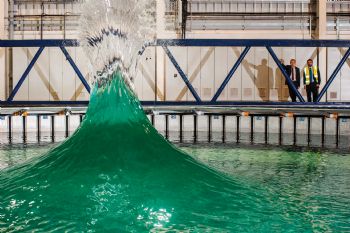
A new marine-energy wave and tidal simulator has officially been opened. The New FloWave Ocean Energy Research Facility has been developed at Edinburgh University with support from the Engineering and Physical Sciences Research Council and Scottish Enterprise.
It is now seeking to work with developers who wish to use its 25m-diameter x 2m-deep tank, which can simulate scale equivalents of waves up to 28m high and currents of up to 14 knots.
The facility was officially opened by Climate Change Minister Amber Rudd who said: “Wave and tidal energy has an important part to play in our low-carbon energy mix and the UK is already at the forefront of R&D in this innovative sector.
"It is great to officially open and see first-hand FloWave’s new marine-energy testing facility. Testing devices in realistic ocean conditions is essential for driving this industry forward to commercial success.”
Stuart Brown, chief executive officer of the facility, said: “FloWave is unique in that it can recreate real sea conditions, combining waves and tides for almost any location or sea state in the world. Its circular design means waves have no reflections and both waves and currents can come from multiple directions, to accurately mimic the real ocean environment.
This means researchers and industrial partners can use the facility to develop and refine prototype devices before building and testing them full-scale for deployment in near-identical conditions at sea.
“We believe FloWave will help accelerate learning, improve performance and reduce costs for developers, and we expect it will be used to test wave- and tidal-energy converters, floating offshore wind platforms and specialist vessels used to install and maintain offshore projects.”